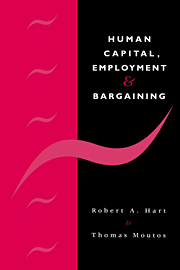Book contents
- Frontmatter
- Contents
- Preface
- 1 Overview
- 2 Labour demand and efficient contract models
- 3 Turnover costs, firm-specific training and unemployment
- 4 Employment and bargaining
- 5 Choice of compensation, unemployment insurance and policy issues
- 6 Team-related human capital and bargaining
- 7 Coalitional versus neoclassical firms
- 8 Future developments
- Bibliography
- Index
6 - Team-related human capital and bargaining
Published online by Cambridge University Press: 05 November 2011
- Frontmatter
- Contents
- Preface
- 1 Overview
- 2 Labour demand and efficient contract models
- 3 Turnover costs, firm-specific training and unemployment
- 4 Employment and bargaining
- 5 Choice of compensation, unemployment insurance and policy issues
- 6 Team-related human capital and bargaining
- 7 Coalitional versus neoclassical firms
- 8 Future developments
- Bibliography
- Index
Summary
Firm-specific human capital as a team investment
Early developments of human capital theory in relation to the firm have taken place largely with respect to the marginal worker. Some key ideas are discussed in section 2.1. To a large extent, concentration on the marginal worker has primarily reflected a desire to achieve analytical simplicity. There are two limitations with this approach, however. First, where production methods entail interrelated work functions across groups of workers – perhaps involving multiple job responsibilities and flexible staffing arrangements – then it is improbable that the firm will determine its training investment on a worker-by-worker basis. In effect, the marginal contribution of any given worker may be too costly to assess adequately because of the integration of tasks combined with the likelihood that different individuals will supply different degrees of work effort per unit of time. Secondly, it is difficult in practice to distinguish realistically between specific and general investment at the level of the individual. Specific investment is designed to improve the individual's job performance in ways that are unique to the firm. The associated literature is hard pressed to offer examples of such investment, resorting to somewhat uninteresting cases (from a general labour market perspective) such as aspects of military training. For example, to what extent can a piece of hardware or software developed solely by a single firm with respect to the job requirements of individual workers be regarded as ‘unique’ in the sense that knowledge of its use and function is of no value to other firms?
- Type
- Chapter
- Information
- Human Capital, Employment and Bargaining , pp. 130 - 162Publisher: Cambridge University PressPrint publication year: 1995



